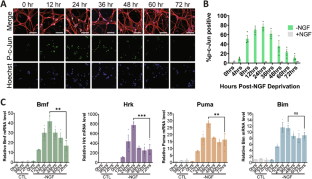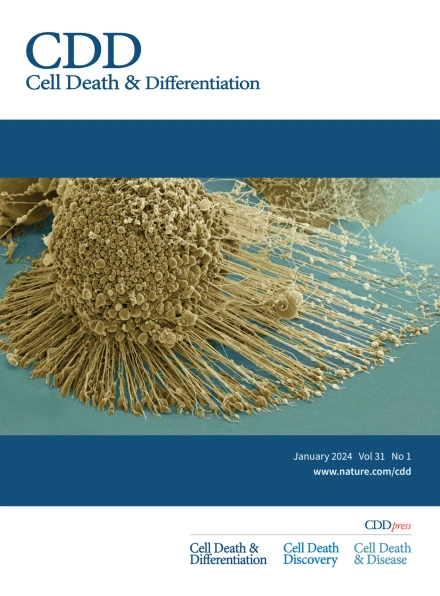凋亡信号在神经元中作为瞬时脉冲被激活
IF 13.7
1区 生物学
Q1 BIOCHEMISTRY & MOLECULAR BIOLOGY
引用次数: 0
摘要
细胞凋亡是所有哺乳动物细胞的基本过程,但它在不同原代细胞中究竟是如何调控的,目前仍鲜有研究。在大多数情况下,细胞凋亡是为了消灭细胞。然而,有丝分裂后的细胞(如神经元)必须有效地平衡发育凋亡的需要和长期存活的生理需要。即使在细胞色素 c 释放点之后,神经元也能够逆转死亡承诺。神经元从凋亡信号中恢复的这种能力表明,神经元中凋亡途径的激活可能比目前公认的要短暂得多。在此,我们研究了神经元中的凋亡途径是一个持续的信号,还是在凋亡刺激持续存在时的一个瞬时脉冲。我们从凋亡信号转导的三个关键步骤进行了研究:c-Jun 磷酸化、纯 BH3 家族蛋白诱导和 Bax 激活。令人震惊的是,我们发现在神经生长因子(NGF)剥夺诱导交感神经元凋亡后,所有这三个事件都会以瞬时信号的形式出现。如果凋亡刺激发生逆转,这种瞬时凋亡信号将有效地使神经元复位并允许恢复。令人兴奋的是,我们还发现神经元从凋亡信号中恢复的能力取决于抗凋亡 Bcl-2 家族蛋白 Bcl-xL 的表达。缺乏 Bcl-xL 的神经元即使在 NGF 恢复后也无法从 NGF 缺失中恢复。此外,我们还发现,从之前的 NGF 剥夺中恢复过来的神经元对随后的 NGF 剥夺具有保护作用。这些结果共同定义了神经元凋亡调控的一种新机制,在这种机制中,凋亡信号的短暂脉冲支持神经元的恢复能力。本文章由计算机程序翻译,如有差异,请以英文原文为准。


Apoptosis signaling is activated as a transient pulse in neurons
Apoptosis is a fundamental process of all mammalian cells but exactly how it is regulated in different primary cells remains less explored. In most contexts, apoptosis is engaged to eliminate cells. However, postmitotic cells such as neurons must efficiently balance the need for developmental apoptosis versus the physiological needs for their long-term survival. Neurons are capable of reversing the commitment to death even after the point of cytochrome c release. This ability of neurons to recover from an apoptotic signal suggests that activation of the apoptotic pathway in neurons could be much more transient than is currently recognized. Here, we investigated whether the apoptotic pathway in neurons is a persistent signal or a transient pulse in continuous presence of apoptotic stimulus. We have examined this at three key steps in apoptotic signaling: phosphorylation of c-Jun, induction of the BH3-only family proteins and Bax activation. Strikingly, we found all three of these events occur as transient signals following Nerve Growth Factor (NGF) deprivation-induced apoptosis in sympathetic neurons. This transient apoptosis signal would effectively allow neurons to reset and permit recovery if the apoptotic stimulus is reversed. Excitingly, we have also discovered that a neuron’s ability to recover from an apoptotic signal is dependent on expression of the anti-apoptotic Bcl-2 family protein Bcl-xL. Bcl-xL-deficient neurons lose the ability to recover from NGF deprivation even if NGF is restored. Additionally, we show that recovery from a previous exposure to NGF deprivation is protective against subsequent deprivation. Together, these results define a novel mechanism by which apoptosis is regulated in neurons where the transient pulse of the apoptotic signaling supports neuronal resilience.
求助全文
通过发布文献求助,成功后即可免费获取论文全文。
去求助
来源期刊

Cell Death and Differentiation
生物-生化与分子生物学
CiteScore
24.70
自引率
1.60%
发文量
181
审稿时长
3 months
期刊介绍:
Mission, vision and values of Cell Death & Differentiation:
To devote itself to scientific excellence in the field of cell biology, molecular biology, and biochemistry of cell death and disease.
To provide a unified forum for scientists and clinical researchers
It is committed to the rapid publication of high quality original papers relating to these subjects, together with topical, usually solicited, reviews, meeting reports, editorial correspondence and occasional commentaries on controversial and scientifically informative issues.
 求助内容:
求助内容: 应助结果提醒方式:
应助结果提醒方式:


